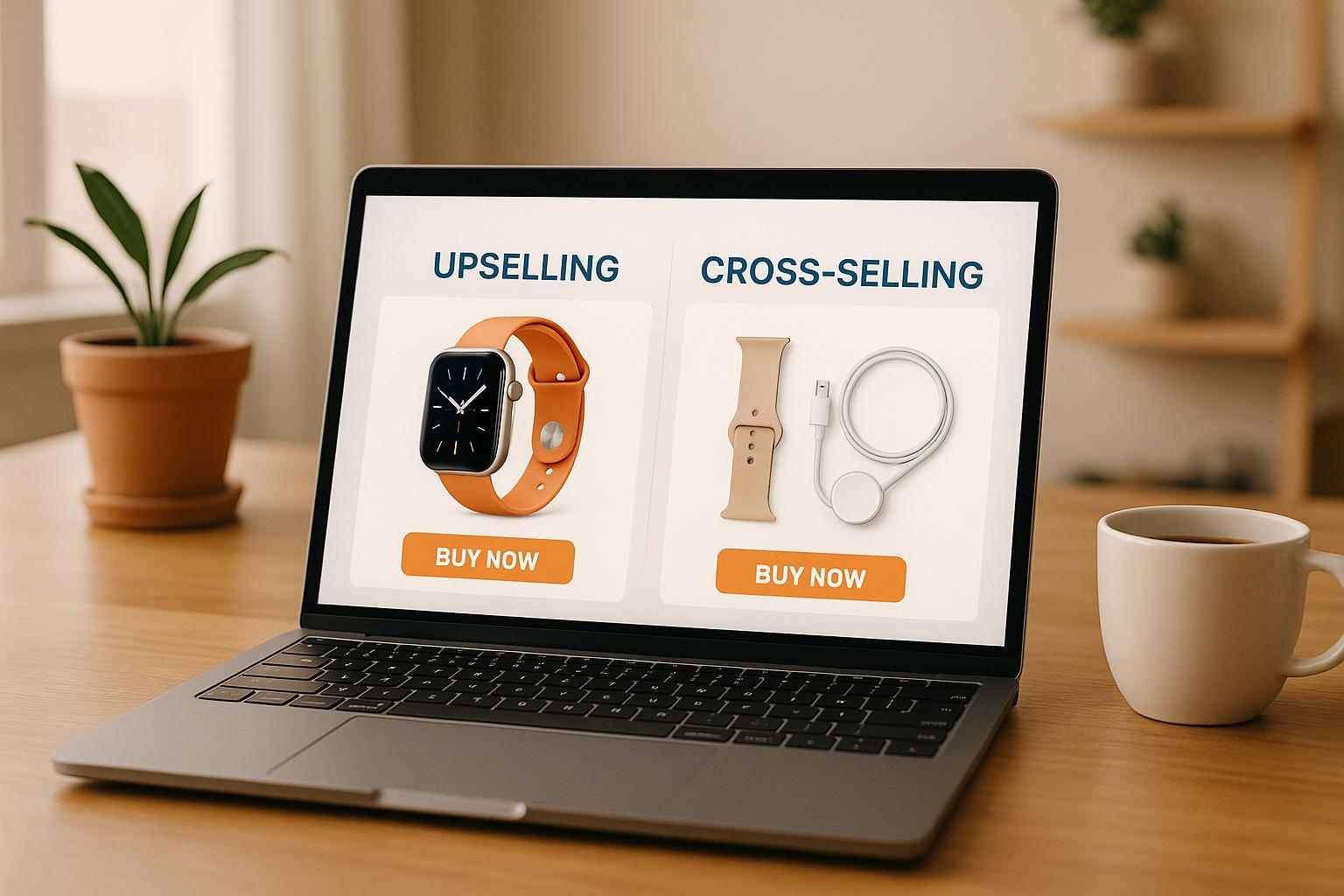AI upselling and cross-selling are two strategies that use artificial intelligence to boost sales by offering personalized product recommendations. Here’s a quick breakdown:
- Upselling: Encourages customers to buy premium or higher-value versions of a product they’re already considering. Example: Suggesting a laptop with more storage.
- Cross-Selling: Recommends complementary products to enhance the main purchase. Example: Suggesting a phone case with a smartphone.
Quick Comparison
| Aspect | AI Upselling | AI Cross-Selling |
|---|---|---|
| Objective | Increase value of a single purchase | Increase total items in a purchase |
| Timing | During checkout or post-purchase | During exploration or browsing |
| Target Customer | Returning customers | First-time buyers |
| Product Focus | Premium versions | Complementary items |
| Revenue Impact | 20–40% higher customer lifetime value | Up to 30% profit growth |
Both strategies rely on AI to analyze customer behavior, making recommendations more personalized and effective. Combining these approaches can maximize revenue while improving the shopping experience.
The Power Of Upselling & Cross Selling
What is AI Upselling?
AI upselling leverages artificial intelligence to suggest higher-value products or premium versions of items that customers are already considering. While traditional upselling relies on generic prompts, AI upselling takes a more personalized approach by using real-time customer data to tailor recommendations.
By analyzing large volumes of customer data, AI systems deliver highly relevant suggestions in the moment. This makes the experience feel natural and personalized, rather than pushy or sales-driven.
How AI Creates Personalized Recommendations
AI systems craft tailored upselling suggestions by analyzing a variety of customer data points. Using machine learning, they uncover patterns in customer behavior to predict which premium products or upgrades might catch their interest.
Key factors AI considers include:
- Browsing history: Tracking products customers view or compare.
- Purchase history: Identifying spending habits and brand preferences.
- Click-through rates and time on site: Differentiating serious interest from casual browsing.
- Customer segmentation: Grouping similar users to apply successful patterns.
"Personalized offers make 31% of customers feel understood, increase the trust in the brand for 24% of clients and help 37% of consumers feel less overwhelmed during online shopping." – Adobe Survey
This targeted approach works. In 2023, nearly half of US shoppers expressed a preference for personalized product recommendations. Additionally, 56% of customers said they were more likely to return to a retailer after a customized shopping experience.
AI Upselling Examples
Amazon uses advanced AI algorithms to suggest upgraded products based on browsing history, viewed items, and search queries. For example, someone exploring a basic Kindle might be shown a more advanced version. In 2023, 35% of Amazon’s sales were linked to AI-driven recommendations.
Uber applies AI-powered dynamic pricing to maximize revenue. By analyzing real-time factors like demand, supply, traffic, and weather, Uber adjusts fares and presents premium ride options during peak times.
Tony Kealys, a baby products retailer, uses Shopbox AI to recommend curated accessory bundles to parents shopping for strollers.
Kerrigan’s, a craft butcher, implemented personalized email campaigns during Black Friday, tailoring offers based on customers’ previous purchases and browsing habits.
The impact of these strategies is clear: 49% of consumers have made impulse purchases after receiving personalized AI recommendations, and shoppers are 33% more likely to choose a premium option when the added cost is framed as an upgrade rather than a total price increase. Fashion retailers have reported a 41% boost in email-generated revenue from AI-driven personalizations, while Etsy saw a 10% increase in purchases from its AI-powered search system.
These examples highlight how AI upselling combines precision and personalization to drive results. Next, we’ll explore how AI cross-selling complements these efforts to further enhance e-commerce success.
What is AI Cross-Selling?
AI cross-selling works by recommending products that naturally complement a customer’s initial purchase, expanding the overall transaction value. Using machine learning, AI cross-selling analyzes customer behavior – like browsing habits, purchase history, and current shopping cart contents – to deliver tailored product suggestions.
"AI cross-selling and upselling use machine learning algorithms to quickly analyze vast amounts of customer data to prepare personalized recommendations." – Anna Zur, Creatio
Personalized recommendations make a big difference in customer satisfaction. In fact, 31% of shoppers feel better understood when they receive tailored suggestions. This shifts cross-selling from feeling pushy to being genuinely helpful, allowing shoppers to discover items they might not have considered otherwise. By analyzing data in real time, AI pinpoints the perfect add-ons to recommend, making the process seamless and effective.
How AI Identifies Product Add-Ons
AI tools excel at finding connections between products by diving deep into customer data. They analyze everything from past purchases and browsing habits to items viewed and stated interests, uncovering patterns that indicate which products pair well together. Machine learning algorithms continuously refine these suggestions, adapting to current trends and customer preferences.
By combining real-time shopping cart data with predictive analytics, AI ensures these recommendations are delivered at just the right moment, maximizing their relevance. This precision not only enhances the customer experience but also creates more opportunities for businesses to boost sales.
AI Cross-Selling Examples
Many industries have seen success with AI-driven cross-selling strategies. Take Amazon, for example. Its recommendation engine evaluates shopping cart contents, browsing behavior, and purchase history to suggest complementary items. If a customer adds a camera to their cart, Amazon might recommend memory cards, camera bags, or tripods based on similar purchasing patterns.
Financial institutions are also leveraging AI for cross-selling. For instance, Capital Credit Union and NET Federal Credit Union used AI strategies to grow auto loan acquisitions by millions and improve product adoption rates.
In retail, a leading online brand implemented an AI recommendation system that analyzed buying patterns, browsing history, and customer reviews. The result? A 35% increase in cross-selling success and a substantial revenue boost. Similarly, a lifestyle and home decor e-commerce brand saw higher transaction values by displaying complementary items in sections like "Frequently Bought Together" and "Customers Also Bought".
"Understanding the true power of AI-driven cross-selling means recognizing its potential to drive not just sales, but also enhance customer experience." – Alex Voichenko, Head of Content @ ConvertMate
AI-powered chatbots also play a role in driving cross-sell revenue, with businesses seeing a 15–25% increase in revenue from these tools. Personalized recommendations further contribute, delivering a 10–30% revenue lift. These results highlight how AI transforms cross-selling into a reliable and effective strategy for boosting sales and improving customer satisfaction.
Key Differences Between AI Upselling and Cross-Selling
Both AI upselling and cross-selling aim to increase revenue, but they take different approaches to achieve this. AI upselling focuses on encouraging customers to purchase higher-value items, such as premium versions of a product. On the other hand, AI cross-selling promotes additional purchases by suggesting complementary products that go hand-in-hand with the main item.
The goals of these strategies are distinct. Upselling highlights the advantages and added value of a more expensive option, whereas cross-selling enriches the shopping experience by introducing related products that enhance the main purchase. These differences provide a foundation for understanding how timing and customer behavior play a role in each approach.
Timing and customer behavior are critical factors. First-time buyers are often more responsive to cross-selling during the browsing phase, as they are exploring options and open to discovering related products. Returning customers, however, are more likely to respond to upselling during the checkout process or at contract renewal points. These customers already trust the brand and are more inclined to consider premium upgrades.
"Upselling and cross-selling only work when they’re rooted in timing and trust. Data and AI help reps know when the moment is right – but reps still need to earn the right to recommend." – Ryan Vaillancourt, VP of Sales at Revenue.io
Cross-selling is particularly effective for items like accessories – think phone cases for smartphones or memory cards for cameras. Upselling, meanwhile, shines when offering premium alternatives, especially in industries like technology where enhanced features justify a higher price. Amazon’s AI-powered recommendation systems, for instance, contribute to around 35% of its revenue, showcasing the power of these strategies.
Side-by-Side Comparison
| Aspect | AI Upselling | AI Cross-Selling |
|---|---|---|
| Primary Objective | Drive higher revenue from a single sale | Boost purchases with complementary suggestions |
| Timing | During checkout or after a purchase decision | During the exploration phase |
| Product Focus | Premium alternatives within the same category | Related products that enhance the main purchase |
| Customer Type | Ideal for returning customers | Effective with first-time buyers |
| Revenue Impact | Can increase sales by over 4% | Adds up to 0.2% to revenues |
| Pricing Strategy | Appeals to those valuing premium features | Targets price-conscious shoppers |
| AI Implementation | Suggests upgrades based on preferences | Recommends "frequently bought together" items |
These differences highlight when each strategy works best. Cross-selling tends to appeal to shoppers focused on affordability, as the suggested items are usually lower-cost add-ons. Upselling, by contrast, attracts those willing to pay more for premium features.
AI plays a crucial role in refining these recommendations. By analyzing user behavior across various devices and channels, AI ensures a seamless experience, acting like a virtual shopping assistant. It determines not only what to recommend but also when and how to deliver those suggestions.
"Shoppers who were once dazzled by the seemingly endless selection available at many online retailers now bemoan the difficulty of finding what they want. AI-powered curation, content, and search can help customers discover brands and products more effectively – and feel more inclined to make a purchase." – McKinsey
sbb-itb-880d5b6
When to Use Each Strategy in E-commerce
Pairing the right strategy with specific customer behaviors can drive better campaign results.
Best Times to Use AI Upselling
AI upselling shines when customers show clear buying intent and have confidence in your brand. Returning customers are prime candidates since they already trust your product quality and service. According to Gartner, targeting loyal customers with premium upgrades can boost conversion rates by 20%.
For example, in the electronics industry, if a customer is browsing laptops, AI can analyze their behavior and suggest a model with more storage or faster processing. The best time to present these options is during checkout or immediately after they add an item to their cart, ensuring the suggestion feels timely and relevant.
Product comparison pages also provide a great opportunity for upselling. AI-powered tools can dynamically highlight the advantages of premium options. For instance, showing how a top-tier smartphone offers superior camera quality or longer battery life compared to a standard version can make the upgrade more appealing.
Follow-up emails are another effective tool. Based on purchase history, these emails can suggest premium upgrades or enhanced products. Similarly, during the early stages of shopping, complementary recommendations can set the stage for upselling later on.
When AI Cross-Selling Works Best
Cross-selling works particularly well when customers are still exploring their options. First-time buyers, in particular, are more open to suggestions for complementary products as they get to know your offerings.
Product detail pages are a key area for cross-selling. For instance, if someone is looking at a camera, AI can immediately suggest accessories like memory cards, cases, or tripods, emphasizing how these items enhance the primary purchase.
AI chatbots can also play a big role. A 2023 study found that businesses using AI chatbots for real-time recommendations saw a 15–25% increase in cross-sell revenue. These bots guide customers through their journey, offering helpful suggestions as they browse.
Dynamic bundles are another effective tactic. By grouping frequently bought-together items, AI can replicate a strategy that has driven 35% of sales for some companies. For example, bundling a laptop with a mouse and a carrying case provides convenience while increasing the overall order value.
Lower-priced add-ons are particularly appealing for cross-selling. For example, pairing a $15 phone case with an $800 smartphone feels like a natural addition. Post-purchase emails can also nudge customers to consider items they might have missed, keeping the conversation going after the sale.
How to Integrate Both Strategies
Combining upselling and cross-selling throughout the customer journey can maximize revenue at every touchpoint. Personalized AI recommendations make it easier to integrate these strategies seamlessly.
On homepage, category, and product pages, showcase both bundled options and premium upgrades to engage customers early. In the shopping cart, AI can suggest last-minute add-ons (cross-selling) or limited-time discounts on upgrades (upselling). Forrester reported in 2023 that AI-driven discounting strategies can increase upsell conversions by up to 30%.
Email marketing is another powerful tool. Tailor sequences based on customer behavior – new subscribers might receive cross-selling emails introducing a wider product range, while loyal customers can get targeted upsell offers for premium items. Even the thank-you page after a purchase is an opportunity to suggest complementary products for future buys or upgrades for next time.
Customer segmentation is crucial for making these strategies work. By analyzing browsing habits, purchase history, and demographics, AI can deliver tailored recommendations that resonate with each customer. Over 60% of online shoppers are more likely to buy when they see personalized pricing suggestions. Regular testing and optimization ensure these strategies remain effective, with the potential to increase revenue by 10–30% through well-executed personalization.
Conclusion
AI-powered upselling and cross-selling have transformed the landscape of U.S. e-commerce, significantly boosting both revenue and customer satisfaction. Businesses that use AI-driven chatbots for customer interactions report a 15–25% increase in cross-sell revenue, while effective personalization strategies can lead to as much as 30% revenue growth.
When combined, these strategies create a powerful synergy. Cross-selling introduces customers to complementary products, increasing the overall order value, while upselling guides them toward premium options that better match their preferences. AI enhances this process by analyzing customer behavior and identifying the perfect moments to present these offers, creating a highly personalized shopping experience that benefits both businesses and customers.
The advantages go beyond immediate sales. Upselling has been shown to boost customer lifetime value by 20–40% and reduce churn by 28%, securing long-term loyalty in a competitive market. Providing relevant, accurate product suggestions that reflect a deep understanding of customer needs not only builds trust but also fosters lasting relationships.
Leading companies seamlessly integrate these strategies throughout the customer journey, from homepage recommendations to post-purchase follow-ups. By leveraging AI to make data-driven decisions about timing and presentation, businesses can create shopping experiences that feel intuitive and helpful, rather than intrusive or overwhelming.
As AI technology continues to advance, businesses that adopt these personalization strategies now will be well-equipped to meet the growing demand for tailored shopping experiences in the U.S. e-commerce market. A combined, AI-driven approach is no longer just an option – it’s a key to thriving in this competitive space.
FAQs
When should businesses use AI for upselling versus cross-selling to maximize results?
AI-powered upselling works best when the goal is to encourage customers to consider higher-value or premium options. For example, if a customer is looking at a product, suggesting a more advanced version can not only increase revenue but also improve their overall experience. This approach becomes even more effective when combined with predictive analytics and tailored recommendations.
Meanwhile, cross-selling shines when it comes to suggesting complementary or related products. Think of it like recommending accessories or add-ons that go perfectly with the customer’s chosen item. This strategy can significantly increase the total value of their cart. The trick is understanding the context: use upselling to promote upgrades and cross-selling to suggest related items. Done right, both methods can boost revenue while keeping customers happy.
How does customer segmentation improve AI-powered upselling and cross-selling strategies?
The Role of Customer Segmentation in AI-Driven Upselling and Cross-Selling
Customer segmentation plays a key role in making AI-powered upselling and cross-selling strategies more effective. By dividing customers into groups based on shared traits, preferences, and behaviors, businesses can offer recommendations that feel personalized and relevant to each group. This kind of tailored approach makes offers more appealing, which naturally increases the chances of a sale.
AI takes this to the next level by processing massive amounts of customer data to identify patterns and insights that might otherwise be overlooked. With this information, businesses can design focused strategies that not only drive sales but also enhance customer satisfaction and loyalty. By zeroing in on what matters most to each segment, businesses create connections that lead to stronger results and sustained growth.
How do AI-powered chatbots enhance cross-selling in e-commerce?
AI-powered chatbots have become a game-changer for cross-selling strategies, thanks to their ability to deliver personalized product recommendations. By analyzing customer preferences and purchase history, these chatbots can suggest items that genuinely match a shopper’s interests, enhancing the overall shopping experience.
They also excel at timing their engagement. For instance, during checkout, chatbots can suggest relevant add-ons or product bundles that complement what’s already in the cart. This real-time automation not only simplifies the process for businesses but also improves customer satisfaction, boosts conversion rates, and naturally leads to higher average order values.




